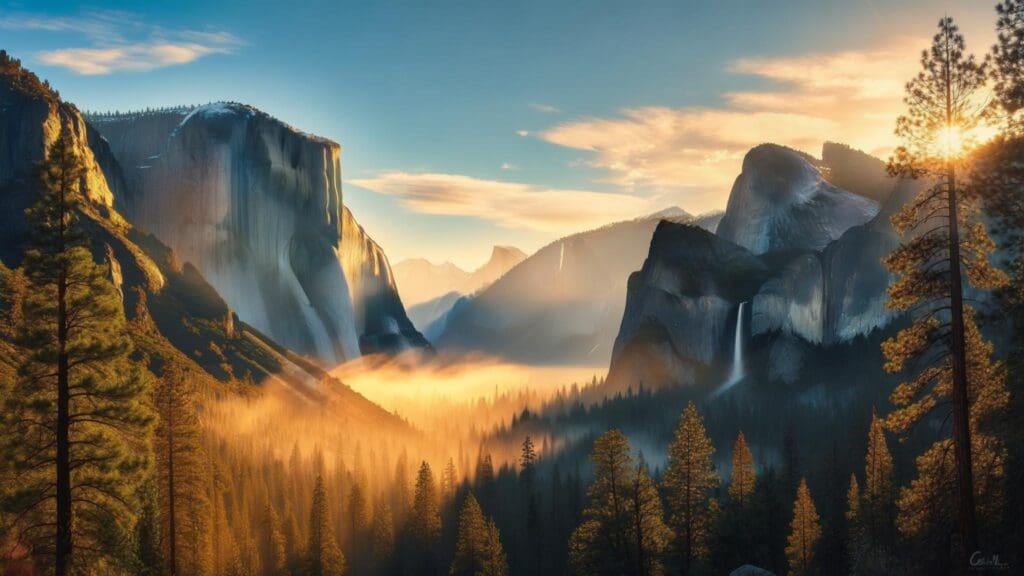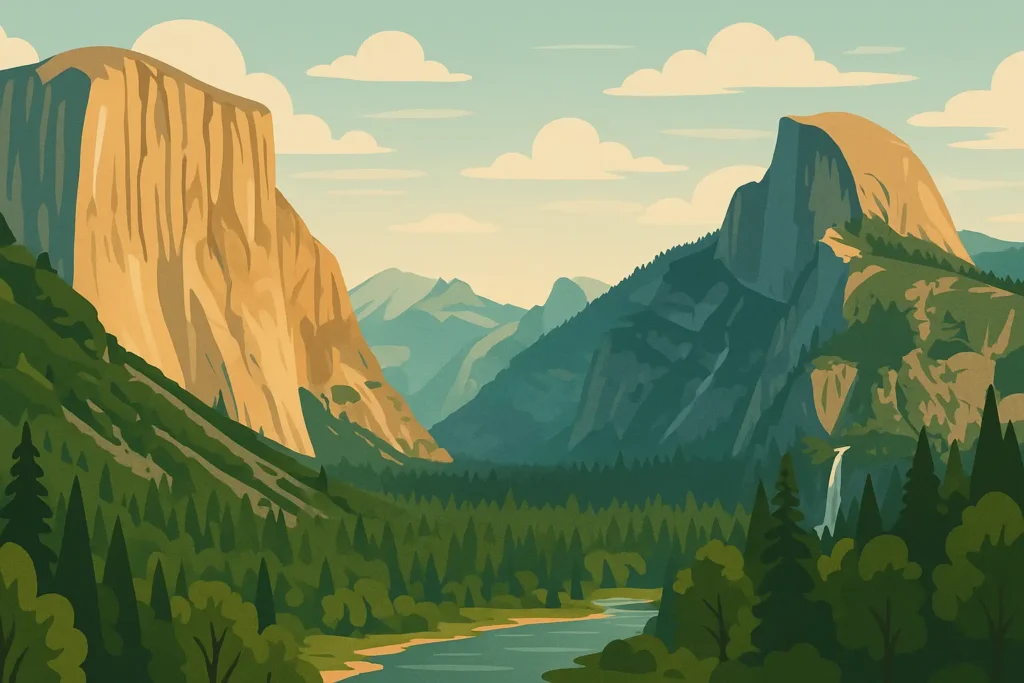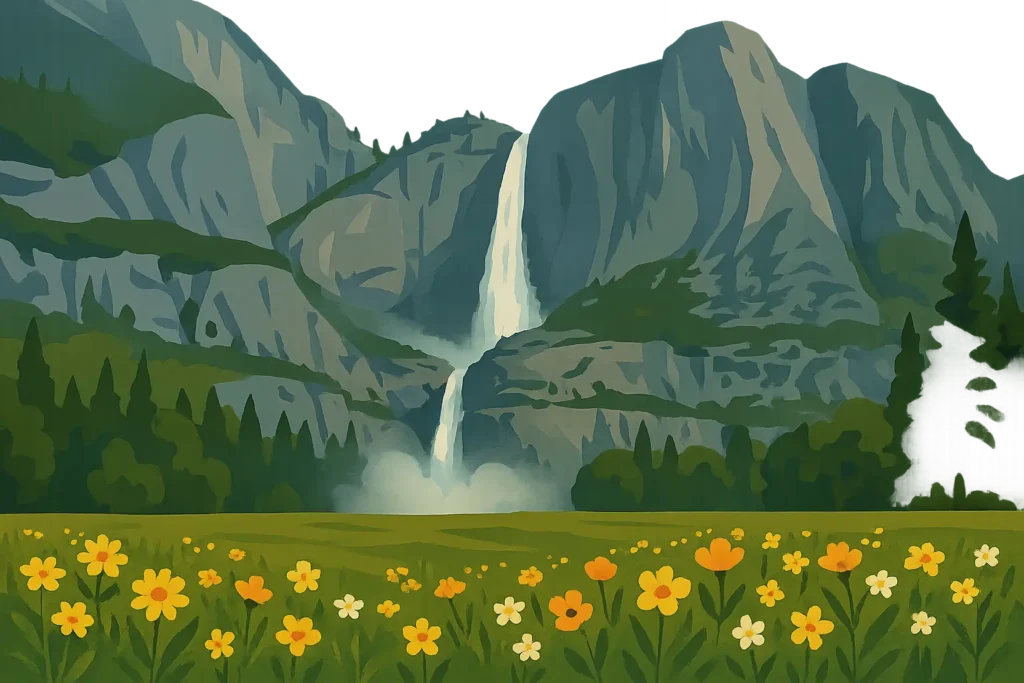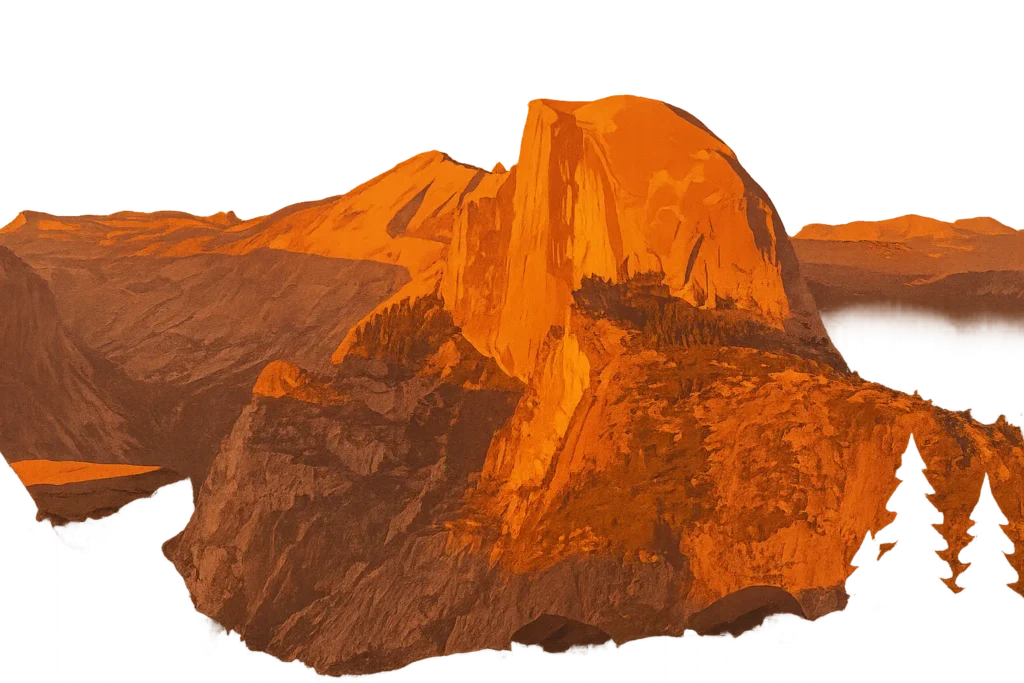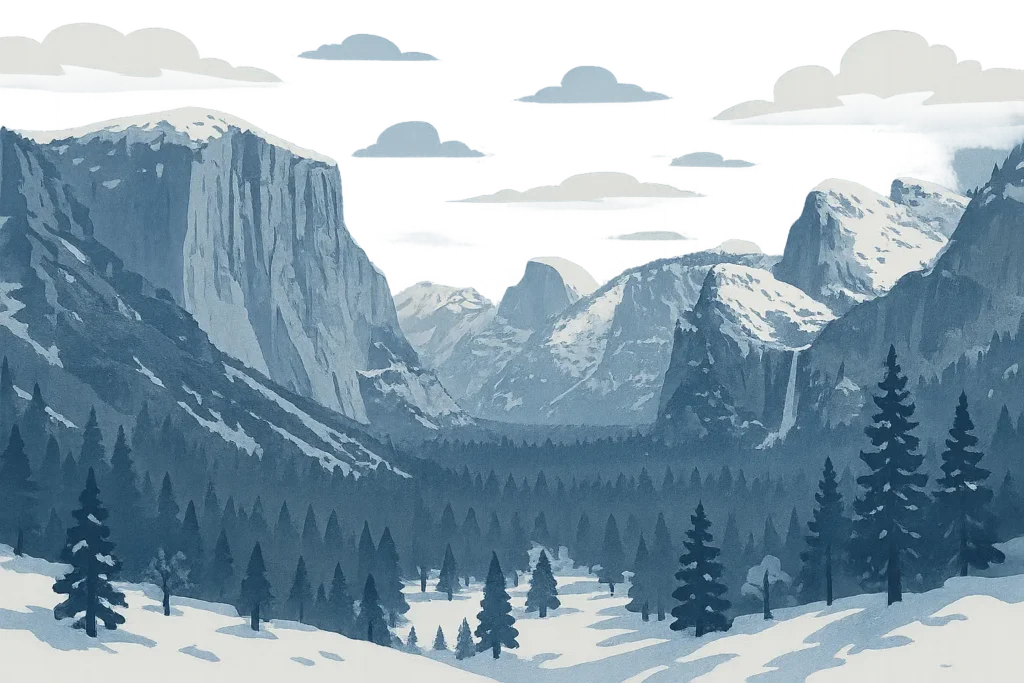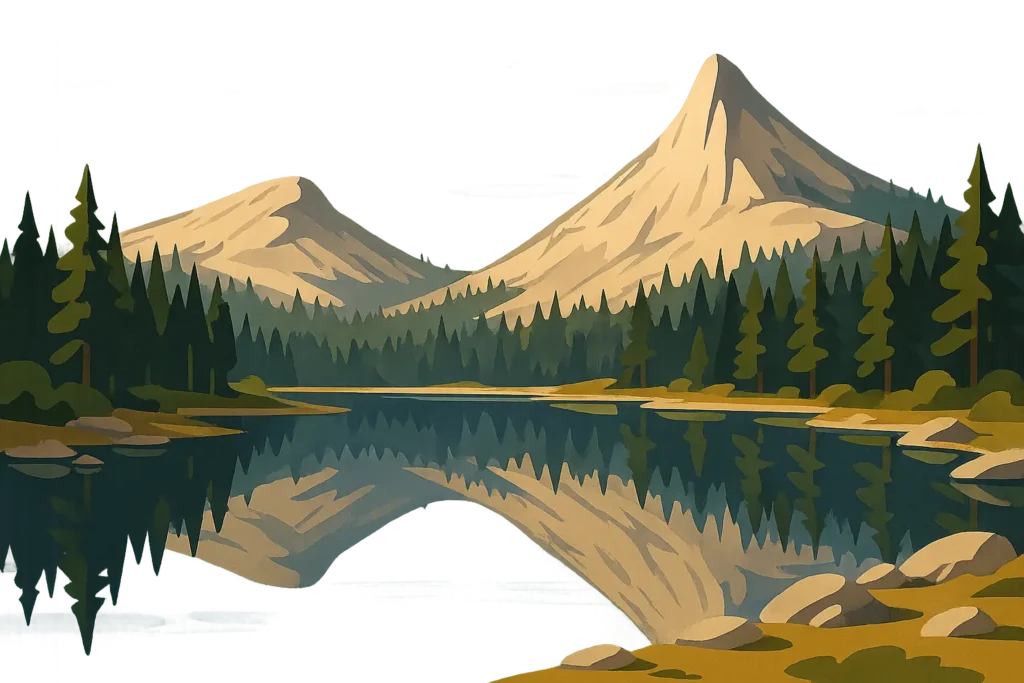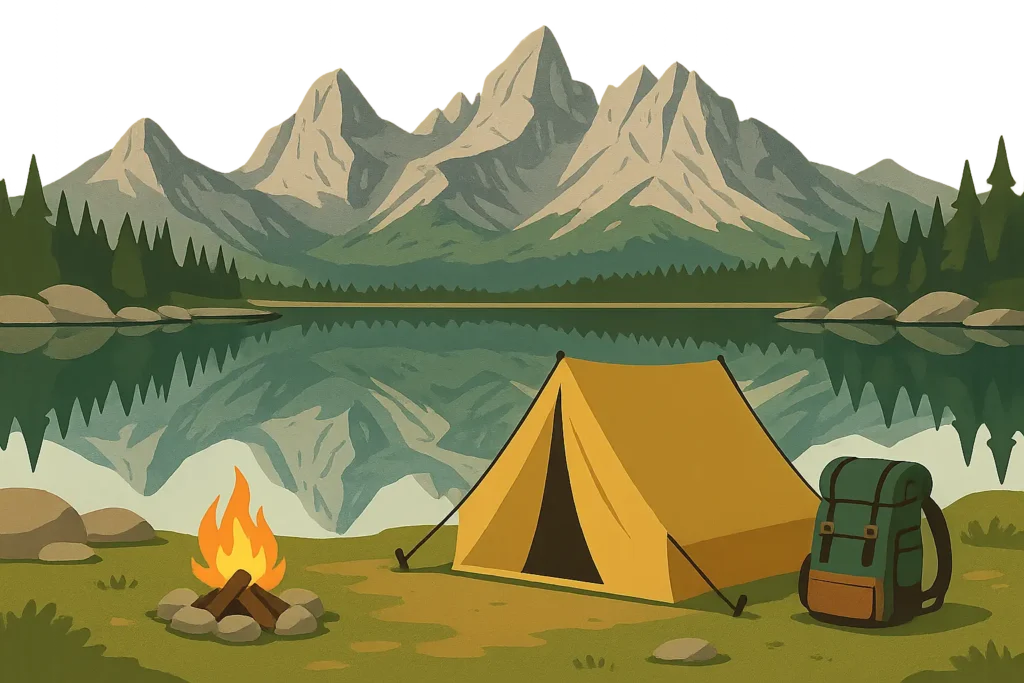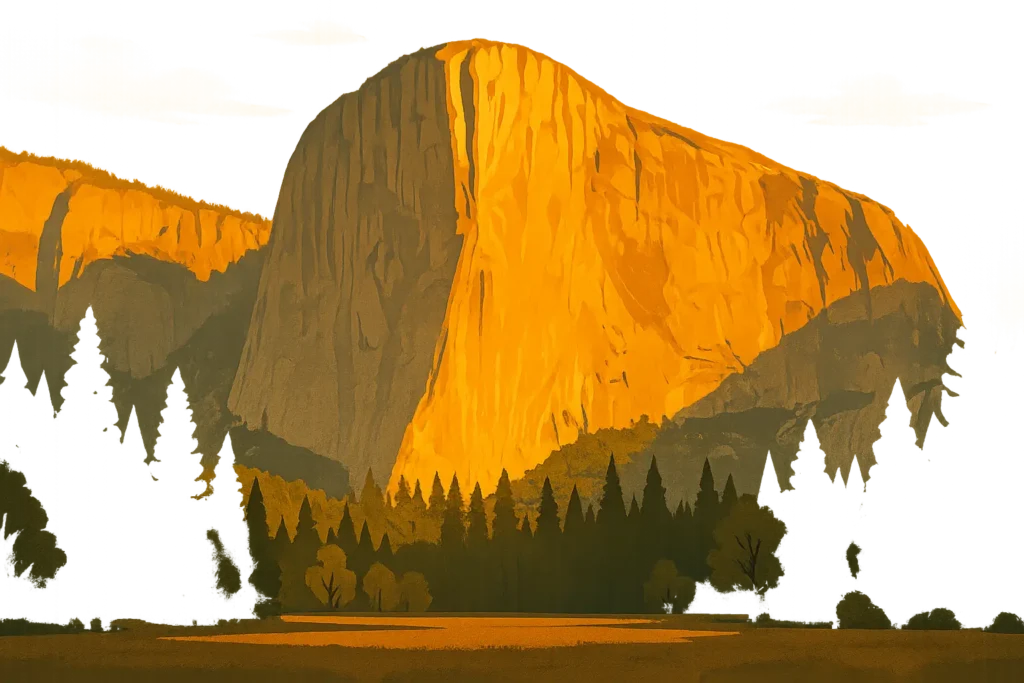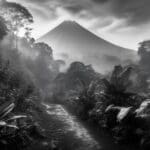Over 4 million visitors flock to Yosemite National Park each year, making it one of America’s most beloved destinations (source). I remember standing in that Yosemite Valley parking lot at 10 AM, already sweating, watching families with perfect hiking gear stride confidently toward trails I couldn’t even pronounce. Meanwhile, I’m googling “how hard is the Mist Trail” while my kids are asking for snacks we forgot to pack. Those towering granite cliffs looked incredible, but I felt completely overwhelmed by the sheer number of options and my complete lack of a plan.
Look, planning the perfect Yosemite adventure doesn’t have to feel like solving a Rubik’s cube blindfolded. Whether you’re squeezing in a quick day trip because that’s all your boss will approve, or you’ve somehow managed to score a week off work, having the right plan makes the difference between coming home with amazing memories and coming home wondering what the heck just happened.
Quick Resources:
-
Plan your personalized adventure with our Vacation Planner
-
Check out all our wedding tools
TL;DR
- The more time you have, the more cool stuff you can see – day trips work if you live nearby, weekends are perfect for most people, extended stays let you actually relax
- Be honest about whether you can walk up three flights of stairs without getting winded – that determines which trails you can handle
- Some roads are closed in winter, spring has epic waterfalls, summer is basically a zoo, and fall is the sweet spot
- Camping costs $35-50/night versus $200-500/night for lodges (but good luck getting reservations)
- That 6 AM start everyone recommends? Yeah, you actually need to do it if you want parking and decent photos
- Getting permits is like trying to buy concert tickets – start way earlier than you think and have backup plans
- Mountain weather changes faster than your teenager’s mood, so check forecasts obsessively
Essential Planning Factors for Your Yosemite Adventure
Before we dive into specific Yosemite vacation ideas, let’s get real about what actually matters when planning your trip. The more time you have, the more awesome stuff you can see. Your fitness level determines whether you’re sticking to paved paths or conquering granite peaks. The season affects everything from which roads are open to whether you’ll melt or freeze. And your accommodation strategy? That’s going to make or break your budget.
Plan your Yosemite escape with our Vacation Planner
Duration and Time Investment – How Much Time Do You Actually Have?
Day trips work if you live within driving distance or have a boss who thinks vacation time is a myth. You’ll hit the major highlights but expect to feel like you’re speed-dating with mountains. It’s better than nothing, and honestly, it often hooks people into planning longer return trips.
Weekend adventures spanning 2-3 days are the sweet spot for most normal humans who have jobs and responsibilities. You can experience both valley floor attractions and high country viewpoints without needing a week to recover. This timeframe lets you tackle one big hiking challenge plus several easier walks without your family staging an intervention.
Extended stays of 4-7 days unlock Yosemite’s real magic. You’ll have time to actually breathe, deal with weather changes, and have those “holy cow, I can’t believe I’m here” moments that make the whole trip worth it. Plus, you won’t feel like you’re in some kind of nature-themed Amazing Race.
| Trip Length | What You’re Really Signing Up For | The Reality Check | Cost Range (Let’s Be Honest) |
|---|---|---|---|
| 1 Day | Cramming Yosemite’s greatest hits into one exhausting day | You’ll see everything, remember half, your feet will hate you | $100-200 (plus gas and regret) |
| 2-3 Days | The sweet spot – enough time to breathe without using all your vacation days | Perfect for most people who have actual lives | $300-800 (depending on how fancy you get) |
| 4-7 Days | Serious exploration with time for weather delays and spontaneous naps | You’ll actually feel like you experienced the park | $800-2000 (worth every penny) |
| 7+ Days | Full wilderness immersion or you’re just showing off | You’ll come back a changed person (or very tired) | $1500-5000+ (but who’s counting?) |
Build your ideal Yosemite itinerary with our Vacation Planner
Physical Fitness Reality Check
Here’s the brutal truth about that “honest self-assessment”: Most of us think we’re in better shape than we actually are. If walking up a parking garage ramp gets you breathing hard, maybe start with the valley floor walks. The mountains will still be there when you’ve built up some stamina.
Beginner-level visitors should stick to paved trails, valley floor walks, and scenic drives. The Valley View Loop and Lower Yosemite Fall trail offer stunning scenery without making you question your life choices. Pro tip I learned the hard way: Those “easy” valley floor walks can still kick your butt if you’re wearing the wrong shoes.
Intermediate hikers can handle moderate trails with 2-6 miles of distance and some uphill suffering. Think Vernal Fall via the Mist Trail or the hike to Taft Point. You’ll need decent cardiovascular fitness, but you won’t need to know how to use ropes or anything scary like that.
Advanced adventurers can tackle the stuff that makes other people go “nope.” Half Dome, multi-day backpacking trips, and routes that require actual climbing skills. Let’s be honest – Half Dome sounds amazing until you realize it’s basically climbing a mountain before breakfast, then doing it again on the way down.
Seasonal Timing Strategy – When to Go (And What You’re Getting Into)
Spring (March-May) brings Yosemite’s waterfalls to peak flow, creating those misty cascades that look like screensavers come to life. Wildflowers bloom everywhere, and the weather’s actually pleasant for hiking. The catch? High country roads might still be closed, and you’ll need layers because mountain weather is moody.
Summer (June-August) is when everything’s open and the park is running at full capacity. Unfortunately, this also means you’ll be sharing those Instagram-worthy viewpoints with approximately everyone else in California. Start your hikes before sunrise if you want parking and photos without strangers’ elbows in them.
Fall (September-November) is the sweet spot – pleasant weather and reasonable crowds. You can actually find parking spots without circling like a vulture, and the hiking weather is perfect. The downside? Many waterfalls look like someone forgot to pay the water bill, but the autumn colors make up for it.
Winter (December-February) turns Yosemite into a peaceful wonderland where you can hear yourself think. Snow activities become possible, and you’ll have those famous viewpoints almost to yourself. Just remember that limited road access means you can’t go everywhere, but honestly, the solitude is magical.
Quick Escapes: Day Trip Adventures
Day trips to Yosemite are like speed dating with nature – you’ll get a taste of everything, but don’t expect deep connections. These work great if you live within a few hours’ drive or if you’re the type of person who thinks vacation planning means checking the weather app the night before.
1. Classic Valley Floor Day Trip
This 8-10 hour marathon hits all the spots you’ve seen on postcards without requiring actual hiking skills. Start at Tunnel View for that iconic El Capitan and Half Dome shot that everyone takes. It’s touristy for a reason – the view actually is that good, and the walk from parking is short enough that you won’t break a sweat.
Next up is Bridalveil Fall, where a 1.2-mile round-trip walk takes you to the base of this 620-foot waterfall. Even when it’s not gushing, the granite bowl around it feels like nature’s cathedral. Fair warning: if it’s peak season, you’ll be sharing this spiritual moment with about 200 of your closest strangers.
End your whirlwind tour at Swinging Bridge and Valley View for sunset photos and a chance to process what you just experienced. These spots offer perfect lighting for those “I was here” shots that’ll make your coworkers jealous.
Mike’s “I Haven’t Hiked Since High School” Comeback: Mike, a 38-year-old accountant, hadn’t done anything more adventurous than walking to his mailbox in years. He planned this exact day trip after his wife threatened to plan their next vacation herself. Starting at 7 AM (which nearly killed him), he managed all the stops, took about 500 photos, and only complained about his feet twice. His secret? Good shoes and realistic expectations. He’s now planning a weekend trip for next year.
Match your trip to your ability with our Vacation Planner
2. Waterfall Spectacular Day Trip
Dedicate 10-12 hours to chasing waterfalls during peak flow season – basically spring, when everything’s gushing like a broken fire hydrant. Start with viewpoints of Yosemite Falls from the valley floor, then work up the courage to tackle the moderate hike to Vernal Fall’s footbridge.
The Mist Trail to Vernal Fall’s base gives you that classic “getting absolutely soaked by waterfall spray” experience that looks amazing in photos but feels like nature’s cold shower. Plan for 4-5 hours of hiking and prepare to question why you didn’t just watch nature documentaries from your couch.
If you’re feeling ambitious (or masochistic), continue to Nevada Fall’s base. Otherwise, spend the remaining time hitting other waterfall viewpoints and congratulating yourself for not wimping out.
3. Glacier Point Sunset Adventure
This 6-8 hour trip focuses on the park’s most spectacular high-elevation viewpoints without requiring you to actually climb anything substantial. The drive up Glacier Point Road is winding enough to make your passengers nervous, but the payoff is worth the white knuckles.
Glacier Point offers that classic Half Dome view from 3,200 feet above the valley floor. It’s the money shot that makes everyone back home understand why you drove all this way. Washburn Point, just down the road, gives you a slightly different angle with usually fewer people fighting for the perfect selfie spot.
Time everything to end at sunset because that golden hour lighting transforms the granite faces into something that looks too good to be real. That 4 AM wake-up call for sunrise at Glacier Point? It sounds romantic until your alarm goes off, but sunset is almost as spectacular and much more civilized.
4. Mariposa Grove Giant Sequoias
Spend 4-6 hours among trees that were ancient when your great-great-great-grandparents were kids. The Mariposa Grove houses over 500 mature giant sequoias, including the Grizzly Giant that’s been standing for over 2,700 years. These trees make you feel simultaneously insignificant and amazed that you get to share the planet with them.
Map out your nature-filled day with the Vacation Planner
Easy walking trails wind through the grove, making this perfect for families with kids who think hiking is a four-letter word. The peaceful forest atmosphere is a nice break from all that dramatic granite scenery – sometimes you need trees that are just really, really big instead of cliffs that make you dizzy.
This works great for anyone who wants to experience Yosemite without feeling like they need to train for a marathon first. Plus, it’s one of the few places where “I hugged a 2,000-year-old tree” is a completely normal thing to say.
Weekend Warriors: 2-3 Day Getaways
Weekend trips are the goldilocks of Yosemite vacation ideas – not too short, not too long, but just right for most people who have jobs, mortgages, and pets that need feeding. These 2-3 day adventures let you see the highlights without needing a week to recover or a second mortgage to pay for it.
5. First-Timer’s Weekend
Your inaugural Yosemite weekend should focus on the stuff everyone talks about without overwhelming yourself with too many options. Day one is all about valley floor exploration, starting with the visitor center where rangers will tell you everything you should have researched beforehand but didn’t.
Spend your afternoon at Tunnel View and Bridalveil Fall – two stops that require minimal effort but deliver maximum “wow, I can’t believe this is real” moments. These spots give you that classic Yosemite experience without making you question your fitness level or navigation skills.
Day two takes you up Glacier Point Road for those famous high-elevation views that make your valley floor photos look quaint by comparison. The drive is scenic enough to count as an activity, and the viewpoints offer completely different perspectives on everything you saw yesterday. End with an easy valley walk or giant sequoia visit, depending on whether your legs are speaking to you.
6. Waterfall Weekend
Time this perfectly for peak waterfall season (April through June) when everything’s flowing like nature turned on all the faucets at once. Day one covers the accessible falls – Lower Yosemite Fall and Bridalveil Fall provide serious wow factor without requiring technical hiking skills or questioning your life choices.
Day two brings the real challenge with the Mist Trail to Vernal Fall. This moderate hike gains enough elevation to make you breathe hard while rewarding you with getting completely soaked by waterfall spray. It’s like a theme park ride, but with more granite and fewer safety rails.
Day three is the Mirror Lake loop, a gentler walk that gives your legs a break while still providing different valley perspectives. This pacing prevents you from hobbling home like you’ve been in a fight with a mountain.
7. Photography Weekend
Serious photographers (or people who want their Instagram to look professional) need this specialized weekend that maximizes those golden hour opportunities everyone talks about. Day one starts before sunrise at Tunnel View – yes, that means setting an alarm that makes you question your sanity, but the morning light on El Capitan is worth the temporary hatred of your alarm clock.
Day two focuses on Glacier Point for sunrise, then Olmsted Point for different granite perspectives. Afternoon light at Taft Point creates those dramatic cliff-edge shots that make people back home nervous just looking at them.
Day three is detail work – macro photography in the sequoia grove, reflection shots wherever can find still water, and sunset compositions from Valley View. This itinerary requires early mornings and late evenings, but your photo collection will make the sleep deprivation worth it.
8. Family Adventure Weekend
Families with kids need this carefully planned weekend that balances education, easy activities, and keeping everyone happy enough to avoid meltdowns. Start at the Valley Visitor Center for junior ranger program signup – it’s like school, but fun, and the kids get badges.
Day two combines the accessible Mariposa Grove with ranger-led programs where kids learn about trees older than civilization while parents get a break from answering “are we there yet?” These guided activities keep everyone engaged while sneaking in actual education.
Final day activities include valley floor biking on paved paths and nature walks short enough that nobody has time to complain. Evening ranger talks provide entertainment while teaching about park wildlife – it’s like nature TV, but live and without commercials.
Extended Explorations: 4-7 Day Journeys
Extended stays are when Yosemite stops being a tourist destination and starts being a place that changes how you think about mountains, wilderness, and what you’re actually capable of accomplishing. These longer adventures let you tackle the big goals, deal with weather changes, and have those transformative moments that make great stories later.
9. Complete Yosemite Experience (5 Days)
This comprehensive adventure covers everything worth seeing while maintaining a pace that won’t require physical therapy afterward. Day one is arrival and orientation – getting permits, checking conditions, and figuring out where everything is so you don’t spend the rest of your trip lost.
Day two explores Glacier Point Road thoroughly, including hikes to Taft Point and quality time at multiple viewpoints. This high-elevation day helps your body adjust to mountain air while delivering scenery that makes your phone camera work overtime.
Day three is the big challenge day – either Half Dome (if you won permits and have a death wish) or the full Mist Trail to Nevada Fall. This demanding day requires starting before most people consider it morning, but provides the trip’s highlight achievement and serious bragging rights.
Day four ventures to Tuolumne Meadows (when accessible) for high country alpine scenery that’s completely different from valley granite, or explores Hetch Hetchy for a different perspective on Yosemite’s granite landscape. These areas offer solitude and ecosystems you can’t find in the crowded valley.
Day five is recovery and departure prep – gentle valley walks, souvenir shopping for people back home, and final photo opportunities. This pacing prevents you from limping home like you fought a bear and lost.
10. Hiker’s Paradise (6 Days)
Serious hikers will love this challenging adventure that tackles the trails everyone talks about in hushed, reverent tones. Day one is acclimatization with easy valley walks and gear prep – basically getting your body ready for the punishment you’re about to inflict on it.
Day two conquers the Mist Trail to both Vernal and Nevada Falls – 7 miles with 2,000 feet of elevation gain that serves as your warm-up for bigger challenges. If this feels easy, you’re ready. If it doesn’t, maybe reconsider your life choices.
Day three attempts Half Dome, the park’s ultimate hiking challenge that requires permits, cables, and 16-17 miles of wondering why you didn’t just stay home and watch Netflix. This iconic summit provides lifetime bragging rights and incredible 360-degree views that make the suffering worth it.
Day four explores Cathedral Lakes in Tuolumne Meadows for alpine lake scenery and a more moderate day that lets your legs remember what it feels like to not hate you. The high country environment provides different ecosystems and granite formations that prove Yosemite has more tricks up its sleeve.
Day five tackles Clouds Rest, Yosemite’s highest peak accessible by trail. The 14-mile round trip and 2,300 feet of elevation gain reward hikers with panoramic Sierra Nevada views that make you understand why people become obsessed with mountains.
Day six allows for gentle recovery walks, gear cleaning, and celebration of surviving the week’s challenges. This itinerary requires excellent fitness but delivers hiking experiences you’ll never shut up about (in the best way).
| Trail Name | Distance | Elevation Gain | Difficulty Level | Best Season | Permit Drama |
|---|---|---|---|---|---|
| Half Dome | 16-17 miles | 4,800 ft | “Why did I do this?” | May-Oct | Lottery system nightmare |
| Mist Trail to Nevada Fall | 7 miles | 2,000 ft | Moderate suffering | Apr-Oct | Thankfully, no |
| Clouds Rest | 14 miles | 2,300 ft | Serious commitment | Jun-Oct | Nope |
| Cathedral Lakes | 6 miles | 1,000 ft | Actually reasonable | Jun-Oct | Nope |
| Vernal Fall | 3 miles | 1,000 ft | Good starter challenge | Apr-Oct | Nope |
11. Backcountry Adventure (7 Days)
This wilderness-focused experience requires advance permits and serious backpacking skills – basically, you need to be comfortable being uncomfortable for days at a time. Days one and two involve permit pickup, gear inspection, and base camp setup while completing practice hikes that reveal whether you packed too much stuff (you did).
Days three through five form the core wilderness experience with multi-day backpacking loops through areas where cell service is a distant memory. Routes vary by season and permit availability but typically include alpine lakes, granite passes, and complete solitude that either transforms you or makes you appreciate civilization more.
Day six provides resupply opportunities, shower access, and rest before departure. This transition day helps you process the wilderness experience while remembering what soap feels like.
Day seven offers final day hikes or departure flexibility depending on whether you’re flying home or driving. This adventure transforms people through extended wilderness immersion and learning that you can survive with way less stuff than you thought you needed.
12. Seasonal Showcase (4 Days)
This adaptable adventure maximizes whatever season you visit by focusing on that time’s unique advantages instead of fighting against them. Spring versions emphasize waterfall viewing, wildflower photography, and temperatures that don’t make you question your sanity.
Summer itineraries take advantage of full park access, including high country areas that are buried under snow the rest of the year. Early morning starts become absolutely essential unless you enjoy hiking in an oven while fighting crowds for parking.
Fall versions focus on photography opportunities, comfortable hiking weather, and the peaceful atmosphere that comes with kids being back in school. Changing aspen colors add seasonal beauty that makes up for the waterfalls looking like decorative drips.
Winter showcases transform everything completely – snowshoeing, cross-country skiing, and the magical solitude of snow-covered granite landscapes. Limited access requires modified expectations but delivers unique experiences and the rare chance to have famous viewpoints to yourself.
Specialized Interest Adventures
These focused adventures cater to specific obsessions and skill sets, from rock climbing and photography to nature study and wellness retreats. They require more preparation and often professional instruction, but they provide deep expertise development and unique perspectives on what makes Yosemite special beyond just the pretty views.
13. So You Want to Try Rock Climbing (Without Dying) – 5-7 Days
Yosemite’s granite walls attract climbers worldwide, and this adventure introduces the sport without requiring you to already be Spider-Man. Day one involves gear rental, route planning, and safety instruction where you learn that climbing harnesses make everyone look ridiculous but keep you alive.
Days two and three focus on beginner walls where new climbers learn basic techniques on less intimidating terrain. These areas provide solid granite and manageable grades for skill development, plus you’re close enough to the ground that falling doesn’t require helicopter rescue.
Days four and five progress to intermediate routes like Royal Arches or Snake Dike on Half Dome. These classic climbs require more technical skills but remain achievable for developing climbers with proper instruction and only moderate terror.
Advanced days tackle more challenging objectives or provide rest time for your newly discovered climbing muscles. The progression lets climbers build skills safely while experiencing world-class granite climbing that spoils you for climbing anywhere else.
14. Photography Master Class (4 Days)
This intensive workshop develops serious photography skills in one of the world’s most photogenic locations – basically, if you can’t get good photos here, maybe stick to phone snapshots. Day one covers golden hour fundamentals at classic locations, teaching composition basics and camera settings that actually matter.
Day two advances to specialized techniques including long exposure work, HDR photography, and composition concepts that separate Instagram snapshots from portfolio pieces. You’ll learn to handle challenging lighting conditions that make most cameras cry.
Day three focuses on wildlife and macro photography, teaching telephoto techniques and close-up work in environments where these skills actually matter. These abilities round out a complete photography education instead of just landscape shots.
Day four involves portfolio development, image editing instruction, and constructive critique sessions. You’ll leave with improved technical skills and a collection of Yosemite images that don’t look like everyone else’s vacation photos.
15. Naturalist’s Journey (5 Days)
This educational adventure develops deep understanding of Yosemite’s natural systems through hands-on learning instead of just looking at pretty rocks. Day one begins with geology tours that explain how glaciers carved the valley and created granite formations that make geologists weep with joy.
Day two focuses on plant identification hikes, teaching participants to recognize native species, understand ecological relationships, and appreciate botanical diversity beyond “that’s a pretty flower.” Seasonal variations provide different learning opportunities throughout the year.
Day three emphasizes wildlife tracking and observation techniques, developing skills to spot and identify creatures that call Yosemite home. Early morning and evening sessions maximize wildlife viewing while teaching you that most animals are smarter than tourists.
Day four combines astronomy programs with night photography, revealing Yosemite’s incredible dark skies and teaching celestial navigation basics. You’ll learn that light pollution is a real problem and that stars actually exist beyond city limits.
Day five involves participation in actual conservation projects, letting visitors contribute meaningfully to park preservation while learning about ongoing research and management challenges that keep this place functioning.
16. Wellness Retreat (4 Days)
This restorative adventure combines gentle outdoor activities with mindfulness practices for people who need nature therapy more than nature conquest. Day one starts with arrival, gentle walks, and guided meditation sessions in peaceful valley locations where the biggest stress is choosing which view to stare at.
Day two incorporates sunrise yoga with granite dome backdrops, followed by therapeutic hiking that emphasizes mindful movement and nature connection rather than distance goals or summit achievements. It’s hiking for your soul instead of your fitness tracker.
Day three introduces forest bathing practices, teaching participants to slow down and engage all senses while moving through different ecosystems. These techniques reduce stress and increase nature connection while proving that you don’t need to conquer mountains to benefit from them.
Day four focuses on reflection, journaling, and departure preparation, helping participants integrate experiences and develop practices they can continue at home. Because the real goal is taking some of this peace back to your regular life.
Luxury and Comfort Experiences
These premium adventures prioritize comfort and convenience while still providing authentic Yosemite experiences – perfect for people who want nature without giving up creature comforts or celebrating special occasions that deserve something extra. Professional services handle logistics while you focus on enjoyment instead of survival.
17. Glamping Getaway (3 Days)
This upscale camping experience provides outdoor immersion without traditional camping challenges like wondering if that sound outside your tent is a bear or just the wind. Luxury tent accommodations include actual beds, electricity, and nearby bathrooms that don’t require a headlamp and prayer.
Professional guides lead small-group tours to major attractions, sharing expert knowledge while handling all logistics so you can focus on taking photos instead of reading maps. Gourmet meals prepared by camp chefs eliminate the “what’s for dinner?” stress and the inevitable burned hot dogs.
Spa services and comfortable common areas provide relaxation between activities. This option appeals to people wanting authentic outdoor experiences with hotel-level amenities and service – basically, nature for people who like their nature civilized.
18. Historic Ahwahnee Experience (3 Days)
The iconic Ahwahnee Hotel (they renamed it The Majestic but everyone still calls it the Ahwahnee) provides luxury accommodations steeped in Yosemite history. Built in 1927, this grand lodge offers elegant rooms, fine dining, and concierge services that cost more than your car payment but deliver experiences worth the splurge.
Historic tours reveal the hotel’s fascinating past and architectural significance, while concierge services arrange customized activities based on your preferences and abilities. Want a private sunrise tour? They’ll make it happen. Need restaurant reservations? Consider it done.
Fine dining experiences feature locally sourced ingredients and wine pairings that create memorable meals with valley views. This experience suits special occasions and anyone whose back can’t handle one more night on an air mattress.
19. Private Guide Adventure (4 Days)
Personal guides customize every aspect of this premium experience based on individual interests, fitness levels, and goals. Whether focusing on photography, hiking, or natural history, guides adapt daily activities to maximize satisfaction while handling all the details you’d probably mess up anyway.
Transportation, permits, and logistics are handled completely by guide services, eliminating planning stress and allowing guests to focus entirely on experiences instead of wondering if you remembered to pack lunch.
Flexible scheduling accommodates weather changes, energy levels, and spontaneous interests. This option works particularly well for families with diverse interests or visitors with specific accessibility needs that require professional accommodation.
20. Wine Country Combination (5 Days)
This sophisticated adventure combines park exploration with nearby wine region visits for a diverse California experience that proves you can have nature and civilization in the same trip. Days one through three focus on park highlights with luxury accommodations and guided activities.
Days four and five transition to wine country featuring vineyard tours, tastings, and gourmet dining that showcase regional specialties. It’s like having two vacations in one, assuming your liver can handle the transition from mountain air to wine country indulgence.
Luxury accommodations throughout maintain comfort levels while providing different perspectives on California’s diverse landscapes and cultures. Perfect for couples who can’t agree on outdoor adventure versus wine tasting.
Mark and Jennifer’s 25th Anniversary Celebration: This couple wanted to commemorate their silver anniversary with luxury and romance instead of sleeping bags and freeze-dried food. They booked the Historic Ahwa hnee Experience, staying in a premium suite with valley views that cost more than their first apartment’s rent. Their concierge arranged a private sunrise tour to Glacier Point, followed by couples massages that made them forget about their mortgage payments. Evening dining featured custom menus with wine pairings while watching sunset from the hotel’s terrace. The combination of luxury amenities and natural beauty created the perfect milestone celebration without any camping stress or hiking terror.
Adventure and Challenge Itineraries
These demanding adventures push physical and mental limits while providing extraordinary achievements and wilderness experiences that you’ll either treasure forever or use as therapy material. They require excellent fitness, proper gear, and often specialized skills or permits that are harder to get than concert tickets.
21. Attempting Half Dome (And Living to Tell About It) – 3 Days
This focused adventure centers on conquering the park’s most famous hiking challenge that separates the weekend warriors from the seriously committed. Day one involves final preparation, gear checks, and early rest to prepare for the demanding summit attempt that starts before most people consider it morning.
Day two begins at 3 AM for the 16-17 mile Half Dome hike with 4,800 feet of elevation gain that will make you question every life choice that led to voluntarily climbing a giant rock. The famous cables section requires gloves, courage, and the ability to not look down at the valley floor 4,800 feet below.
Day three provides recovery time with gentle activities and celebration of this major achievement that most people only attempt once. Many consider Half Dome a life-changing experience that builds confidence for future challenges or teaches them to be satisfied with valley floor walks.
22. John Muir Trail Section (7 Days)
This multi-day backpacking adventure follows portions of the famous 211-mile John Muir Trail through Yosemite’s pristine wilderness where cell service is a distant memory and your biggest decision is which granola bar to eat for lunch. Extensive planning includes wilderness permits, resupply strategies, and route selection based on current conditions and your tolerance for suffering.
Daily hiking distances vary from 8-15 miles depending on terrain and elevation changes that will test every muscle you forgot you had. Participants experience complete wilderness immersion while developing advanced backpacking skills and learning that you can survive with way less stuff than civilization tells you.
Resupply points and exit strategies provide flexibility for weather or emergency situations, because mountain weather doesn’t care about your itinerary. This challenging adventure appeals to experienced backpackers seeking iconic trail experiences and the ability to say they’ve hiked the JMT.
23. Winter Wonderland (4 Days)
Winter transforms Yosemite into a completely different park that requires specialized skills and equipment but rewards you with peaceful solitude and magical scenery. Snowshoeing and cross-country skiing provide access to snow-covered landscapes and frozen waterfalls that look like nature’s art installations.
Winter photography opportunities include snow-laden trees, ice formations, and dramatic weather conditions that create unique artistic possibilities. Plus, you’ll have famous viewpoints almost to yourself because most people are smart enough to stay inside.
Cozy lodge accommodations provide warmth and comfort after cold-weather activities. Limited road access requires modified expectations but delivers experiences that make summer visitors seem like amateurs.
24. Extreme Challenge Week (7 Days)
This demanding adventure combines multiple difficult hikes and technical challenges for serious athletes and experienced hikers who think regular hiking is for beginners. Daily activities might include Half Dome, Clouds Rest, and advanced climbing routes that require actual skills beyond walking uphill.
Physical conditioning requirements are significant, and participants should have extensive hiking experience before attempting this intensive schedule that would make Navy SEALs tired. This isn’t a vacation; it’s an athletic event disguised as sightseeing.
Technical climbing instruction and advanced wilderness skills development round out this comprehensive challenge program designed for people seeking peak performance and bragging rights that last a lifetime.
25. Multi-Park Adventure (10 Days)
This extended journey combines Yosemite with neighboring Sequoia and Kings Canyon National Parks for a comprehensive Sierra Nevada experience that proves California has more mountains than most people realize. The adventure balances different park highlights while managing travel logistics between locations.
Varied accommodations from camping to lodges provide different experiences while maintaining reasonable comfort levels. Activities range from giant sequoia groves to alpine lake hiking and granite dome climbing that showcase the full diversity of Sierra Nevada landscapes.
This comprehensive adventure appeals to serious park enthusiasts wanting to experience the full range of California’s mountain environments in a single extended trip that requires either significant vacation time or early retirement.
| Challenge Level | What You’re Actually Signing Up For | Fitness Reality Check | Experience Requirements | Permit Nightmare Level |
|---|---|---|---|---|
| Moderate Challenge | Day hikes that make you sweat but don’t require rescue | Can walk upstairs without dying | Some hiking experience helpful | Minimal paperwork |
| High Challenge | Half Dome and similar masochism | Excellent fitness and mental fortitude | Extensive hiking background | Advanced permit lottery hell |
| Extreme Challenge | Multiple peak days and technical routes | Peak physical condition and slight insanity | Expert outdoor skills required | Multiple specialized permit disasters |
| Multi-Park Epic | Extended backpacking and varied terrains | Exceptional endurance and commitment | Professional-level experience | Complex permit coordination nightmare |
Detailed Itinerary Breakdowns
These comprehensive examples provide hour-by-hour scheduling and practical details for executing successful Yosemite adventures without losing your mind or your family. They demonstrate how to balance activities, manage time effectively, and handle real-world challenges like parking (the eternal struggle), crowds, and weather that changes faster than your mood.
Example 1: First-Timer’s Weekend (How It Actually Works)
Day 1: Valley Introduction (AKA Figuring Out Where Everything Is)
7:00 AM arrival at Yosemite Valley requires leaving home while it’s still dark, but ensures parking availability and smaller crowds. Park at Swinging Bridge lot, which typically has better availability than the popular spots where everyone fights over spaces like it’s Black Friday.
8:00 AM breakfast at Degnan’s Kitchen provides fuel while avoiding the stress of packing lunches that will get squished in your backpack. The casual atmosphere and valley views create a relaxed start that doesn’t immediately overwhelm first-timers.
9:00 AM Valley Visitor Center orientation takes 30 minutes but provides crucial understanding of park layout, current conditions, and permit information for future visits. Rangers answer questions and help you realize you planned way too much for one day.
10:00 AM easy walk to Swinging Bridge viewpoint takes one hour including photo time. This iconic spot provides classic El Capitan and Bridalveil Fall compositions without significant hiking effort or questioning your fitness level.
11:30 AM drive to Tunnel View for the most famous Yosemite photograph that everyone takes. Parking can be challenging, but the short walk delivers maximum visual impact before afternoon crowds turn it into a photography traffic jam.
1:00 PM lunch at Yosemite Valley Lodge offers convenient dining with outdoor seating options. The central location provides easy access to afternoon activities while avoiding the logistics of keeping sandwiches from becoming pancakes.
2:30 PM Bridalveil Fall hike covers 1.2 miles round trip in approximately 1.5 hours including photography time. Even during low water periods, the granite amphitheater setting creates impressive scenery that justifies the moderate effort.
4:30 PM check-in time allows accommodation setup and rest before evening activities. Whether camping or staying in lodges, this timing provides flexibility for dinner planning and processing the day’s sensory overload.
6:00 PM dinner and evening ranger programs provide educational entertainment while helping you understand what you actually saw today. Ranger talks cover topics from wildlife to geology, making you feel smarter about your park experience.
Day 2: High Country Perspectives (The Big View Day)
6:00 AM early departure for Glacier Point Road maximizes the day’s potential and ensures parking availability at popular viewpoints. The winding mountain road requires careful driving but provides spectacular scenery that makes the white-knuckle driving worthwhile.
7:30 AM Washburn Point sunrise viewing offers incredible lighting on Half Dome and surrounding granite formations. This timing captures golden hour light that transforms the landscape and makes your phone camera work overtime.
8:30 AM Glacier Point main viewpoint provides that classic Half Dome perspective from 3,200 feet above the valley floor. Multiple viewing areas accommodate crowds while offering different photographic angles and the chance to catch your breath.
10:00 AM Taft Point hike covers 2.2 miles round trip in 1.5 hours, including time at the dramatic cliff-edge viewpoint that makes people nervous just looking at photos. This moderate walk provides spectacular valley views with minimal elevation gain.
12:00 PM lunch at Wawona Hotel offers historic atmosphere and convenient location for afternoon activities. The Victorian-era dining room provides elegant surroundings and regional cuisine that costs more than gas station food but delivers actual flavor.
2:00 PM Mariposa Grove exploration among giant sequoias provides a completely different ecosystem that proves Yosemite has more tricks than just granite. Easy walking trails accommodate all fitness levels while showcasing trees older than civilization.
4:00 PM return to valley allows time for final activities and sunset positioning. Traffic can be heavy during this time, so patience and defensive driving become essential survival skills.
6:00 PM sunset at Valley View provides the perfect ending to your high country day. This location offers excellent western light on granite formations with convenient parking and easy access that doesn’t require heroic effort.
Day 3: Active Valley Exploration (The Recovery Day)
8:00 AM Mirror Lake loop hike covers 5 miles in 2.5 hours, providing different valley perspectives and seasonal lake reflections. This relatively flat walk offers granite dome views without significant elevation gain or the need for mountain climbing skills.
11:00 AM valley floor bike rental and exploration provides efficient transportation between attractions while offering exercise and fresh air. Paved bike paths connect major valley destinations safely, assuming you remember how to ride a bike.
1:00 PM lunch and packing time allows meal enjoyment while organizing gear for departure. This timing provides flexibility for final activities or early departure depending on travel schedules and how much your feet hate you.
2:30 PM final valley photography and departure preparation includes last-minute souvenir shopping and route planning for the journey home. This buffer time accommodates unexpected delays or spontaneous activities that always seem to happen.
Example 2: Backcountry Adventure (The Real Deal Implementation)
Pre-Trip Preparation Phase (60 Days Prior – Start Early or Cry Later):
Wilderness permit applications through the lottery system require specific dates and route planning that makes airline booking look simple. Popular areas book immediately, so backup plans become essential survival strategies.
Route planning involves studying topographic maps, understanding water sources, and identifying camping areas while praying that trail conditions cooperate. Weather patterns, seasonal closures, and current conditions affect route selection more than your preferences.
Resupply strategies depend on trip length and route accessibility. Options include pre-positioned caches, mail drops to park facilities, or carrying all supplies from the start like a pack mule with opposable thumbs.
Gear checklists must account for variable mountain weather, bear safety requirements, and wilderness regulations. Shakedown hikes test equipment and identify potential problems before entering areas where the nearest help is measured in days, not minutes.
Day 1: Base Camp and Final Reality Check
Morning permit pickup at the wilderness center includes final route briefing, current condition updates, and bear canister rental. Rangers provide valuable local knowledge about trail conditions and weather forecasts while assessing whether you’re actually prepared for this.
Gear inspection and final packing ensure nothing essential is forgotten while eliminating unnecessary weight. Every ounce matters during multi-day backpacking, so that extra pair of shoes needs to justify its existence.
Afternoon acclimatization hike to Vernal Fall provides elevation exposure and gear testing under actual hiking conditions. This moderate challenge identifies potential equipment issues before entering wilderness areas where “oops” becomes “emergency.”
Evening route briefing and weather assessment help finalize plans and identify potential challenges. Flexibility remains important because mountain conditions change faster than your teenager’s mood.
Backpackers campground provides final night of convenience before wilderness immersion. Shower facilities, food storage, and gear organization opportunities prepare for upcoming challenges while you still remember what hot water feels like.
Days 2-6: Wilderness Immersion Experience (The Real Adventure)
Daily hiking distances vary from 8-15 miles depending on terrain, elevation changes, and camping area availability. Early starts maximize daylight hours and provide flexibility for route adjustments when reality doesn’t match your planning.
Navigation skills become essential as wilderness trails may be less obvious than valley paths. Map and compass proficiency, along with GPS backup, ensure safe route finding when trail markers become suggestions rather than guarantees.
Water filtration and food preparation require careful attention to Leave No Trace principles. Proper waste disposal and campsite selection protect wilderness areas for future visitors while keeping you from becoming a cautionary tale.
Bear safety protocols include proper food storage, clean camping practices, and awareness of wildlife behavior. Bear canisters are required in most wilderness areas and must be used correctly unless you enjoy sharing meals with large, hungry mammals.
Weather monitoring and emergency preparedness become daily considerations. Mountain weather changes rapidly, and evacuation routes should be understood before they’re needed for anything more serious than homesickness.
Day 7: Return and Civilization Shock
Final pack-up and wilderness checkout involve Leave No Trace inspection and permit return. Rangers may ask about trail conditions and wildlife encounters to help future visitors avoid your mistakes.
Reflection hike on easy valley trails provides transition time between wilderness solitude and civilization’s demands. This gentle activity helps process the week’s experiences while readjusting to the concept of paved paths.
Shower facilities and gear cleaning restore comfort while providing time to organize equipment and memories. The contrast between wilderness simplicity and modern convenience becomes strikingly apparent when hot water feels like luxury.
Celebration dinner and trip debrief allow participants to share experiences and plan future adventures. Many find that wilderness backpacking becomes transformative, influencing future life decisions and proving that you need way less stuff than you thought.
Matching Your Trip to Your Needs
This evaluation system helps you select the perfect adventure by analyzing duration requirements, physical fitness demands, seasonal advantages, accommodation strategies, and logistics complexity. Understanding these factors prevents mismatched expectations and ensures your chosen adventure aligns with reality instead of your Instagram fantasies.
Customize your Yosemite plan with our Vacation Planner
Duration and Commitment Analysis – Be Honest About Your Life
Day trips work best for visitors living within 3-4 hours of Yosemite or those whose vacation time is more theoretical than actual. You’ll experience the park’s highlights but should expect a rushed pace that feels like speed dating with mountains. These trips often inspire longer return visits once you understand the park’s scope.
Weekend itineraries provide the sweet spot for most normal humans with jobs, mortgages, and responsibilities. Two to three days allow for one major hiking challenge plus several easier activities, creating satisfying experiences without requiring a sabbatical from life.
Extended stays unlock Yosemite’s transformative potential through proper acclimatization, weather flexibility, and access to remote areas where you can actually hear yourself think. Four to seven days accommodate major goals while providing recovery time and spontaneous exploration opportunities.
Specialized adventures require significant time investments but deliver unique rewards that justify the commitment. Rock climbing expeditions, photography workshops, and wilderness backpacking need extended commitments but provide skills development and experiences impossible during shorter visits.
Physical Fitness Reality Check – No Lying to Yourself
Be brutally honest about your hiking abilities because mountain terrain doesn’t care about your good intentions. If walking up a parking garage ramp gets you breathing hard, stick to valley floor activities, scenic drives, and paved trails with minimal elevation gain. These limitations still provide access to spectacular scenery without requiring rescue services.
Intermediate hikers can handle 5-8 mile days with 1,000-2,500 feet of elevation gain on well-maintained trails. Good cardiovascular fitness and proper footwear become important, but technical skills aren’t required. Most weekend adventures fall into this category.
Advanced adventurers need excellent fitness for 10+ mile days with 3,000+ feet of elevation gain on potentially technical terrain. Multi-day endurance, exposure comfort, and wilderness skills become necessary for challenges that provide lifetime achievement goals.
Honest self-assessment prevents dangerous situations and ensures enjoyable experiences. Overestimating abilities leads to exhaustion, injury, or incomplete adventures, while underestimating limits might cause missed opportunities for appropriate challenges.
David’s Honest Fitness Assessment Success: A 45-year-old office worker, David initially planned the “Hiker’s Paradise” adventure but honestly evaluated his fitness after struggling on local 3-mile hikes. He switched to the “First-Timer’s Weekend” instead, focusing on valley floor walks and Glacier Point drives. By matching his actual abilities rather than his aspirations, David had an amazing experience without exhaustion or disappointment. He’s now training for a more challenging return visit with realistic fitness goals.
Seasonal Optimization Strategies – Work With Nature, Not Against It
Spring visits (March-May) maximize waterfall viewing when snowmelt creates peak flows that look like nature’s special effects. Wildflower displays throughout the valley add seasonal beauty, while moderate temperatures make hiking comfortable instead of torturous. However, high country access may be limited by snow, and weather can be unpredictable.
Summer adventures (June-August) provide complete park access with all roads open and full services available. Unfortunately, this also means maximum crowds, hot valley temperatures, and competitive accommodation booking that makes concert tickets look easy to get. Early morning starts become essential for popular activities.
Fall experiences (September-November) offer the best balance of pleasant weather and manageable crowds. Comfortable hiking temperatures and easier parking make this season ideal for photography and extended exploration. Many waterfalls run dry, but autumn colors and peaceful atmosphere compensate.
Winter visits (December-February) create completely different park experiences through snow activities and peaceful solitude that most people never experience. Limited road access restricts options, but cross-country skiing, snowshoeing, and winter photography provide unique opportunities unavailable during other seasons.
Accommodation Strategy Impact – Money Talks
Camping-focused adventures reduce costs significantly ($35-50/night versus $200-500/night for lodges) while providing authentic outdoor experiences. However, they require full camping equipment, advance reservations exactly 5 months ahead at 7 AM Pacific, and comfort with outdoor living conditions that include interesting bathroom situations.
Lodge-based stays offer private bathrooms, restaurant dining, and weather protection but require booking 12-18 months in advance for peak seasons. Costs range from $300-800/night depending on property and season, but convenience and comfort justify expenses for many visitors who value sleep and hot showers.
Mixed accommodation strategies balance outdoor authenticity with periodic comfort, allowing shower access, gear drying, and resupply opportunities. This approach optimizes budgets by splurging on key nights while saving on others.
Gateway community lodging outside the park provides more affordable options but requires daily driving into Yosemite. Morning commute times can add 1-2 hours to each day, affecting activity scheduling and crowd avoidance strategies.
Logistics Complexity Assessment – Know What You’re Getting Into
Low complexity adventures require minimal advance planning and offer maximum flexibility for people who think planning means checking the weather app. Day trips and basic weekend adventures need standard vehicle access, no special permits, and allow spontaneous route modifications based on conditions or mood changes.
Moderate complexity adventures involve some advance reservations, specific seasonal timing, and basic gear requirements. Photography workshops, family weekends, and luxury experiences need 2-4 weeks of planning but remain manageable for most organized humans.
High complexity expeditions demand extensive preparation including multiple permits, specialized gear, physical conditioning programs, and detailed contingency planning. Half Dome attempts, wilderness backpacking, and technical climbing require 2-6 months of advance work and backup plans for your backup plans.
Getting wilderness permits is like trying to buy concert tickets for your favorite band – everyone wants them, the website crashes at crucial moments, and you’ll probably end up with your third choice. Start this process way earlier than you think you need to.
Cost Analysis Framework – Let’s Talk Real Money
Budget-friendly options ($200-500 total) emphasize camping, self-guided activities, and minimal gear requirements. Day trips with external lodging, packed lunches, and basic supplies keep costs manageable while still providing authentic Yosemite experiences that don’t require selling organs.
Mid-range experiences ($500-1,500 total) include weekend trips with mixed accommodations, some guided elements, restaurant meals, and gear rentals. Photography workshops, family adventures, and moderate hiking challenges fall into this category for people with normal jobs and reasonable expectations.
Premium adventures ($1,500-5,000+ total) feature extended lodge stays, professional guide services, high-end gear, and luxury amenities. Private guides, helicopter access, and exclusive experiences justify higher costs for special occasions or people who consider camping a form of punishment.
Hidden costs include park entrance fees ($35 for 7 days), reservation fees, permit costs, and potential equipment purchases that can significantly impact total trip expenses. That $35 park pass is just the beginning – add gas, food, and the inevitable souvenir t-shirt your kid will outgrow in six months.
Let’s talk money because nobody else will: Budget at least double what you think you’ll spend. A sandwich at the lodge costs $18, gas stations are scarce, and everything costs more in the mountains because capitalism works differently at elevation.
Success Metrics That Actually Matter
Forget about conquering peaks or getting the perfect Instagram shot. Success in Yosemite is simpler: Did you see something that made you go “whoa”? Did you feel proud of yourself for trying something new? Did you NOT get lost, injured, or divorced during the planning process? Congratulations, you nailed it.
Beginner success focuses on completing planned activities safely while developing positive emotional connections to the park. Basic photography skills, confidence for future outdoor adventures, and appreciation for wilderness values indicate successful introductory experiences.
Intermediate achievements include overcoming significant physical challenges, developing technical skills, and demonstrating leadership capabilities during group activities. Deep appreciation for wilderness values and conservation mindset development mark successful progression beyond tourist status.
Advanced accomplishments involve lifetime achievement goals, wilderness self-sufficiency demonstration, and inspiration to protect natural spaces through advocacy or volunteer work. These transformative experiences often influence major life decisions and create lifelong outdoor enthusiasts.
Realistic expectation setting prevents disappointment while ensuring appropriate challenge levels. Weather, crowds, and physical limitations can affect outcomes, but proper planning and flexible attitudes maximize success regardless of specific goal achievement.
How Bridesmaid for Hire Can Enhance Your Yosemite Adventure
Planning the perfect Yosemite adventure requires the same attention to detail and personalized care that makes weddings unforgettable. Whether you’re organizing a proposal at Glacier Point, celebrating an anniversary with a romantic getaway, or coordinating a group adventure for a bachelorette party, professional planning support can transform good trips into extraordinary experiences.
At Bridesmaid for Hire, we understand that life’s biggest moments deserve expert coordination and stress-free execution. Just as we help brides navigate wedding planning complexities with personalized guidance, your Yosemite adventure benefits from the same level of thoughtful preparation and professional support.
Consider professional assistance for your Yosemite celebration, especially when combining park visits with special occasions. From coordinating logistics for large groups to ensuring perfect timing for mountaintop proposals, experienced planners handle details while you focus on creating memories.
Our skills in managing group dynamics, coordinating complex schedules, and providing calming organizational presence translate perfectly to adventure planning. After all, everyone deserves support from someone who’s actually paid to care during life’s most important moments, whether it’s coordinating your wedding day or planning your dream adventure.
Final Thoughts
Your perfect Yosemite adventure exists within these 25 itineraries, waiting to be discovered through careful consideration of your personal constraints and actual capabilities instead of your hiking fantasies. Whether you’re drawn to the accessibility of valley floor walks or the challenge of Half Dome’s cables, success depends on matching your chosen adventure to reality.
Here’s what nobody tells you about Yosemite: It’s going to be different than you planned. Your perfect sunrise photo will be blocked by clouds. Your easy hike will feel harder than expected. Your kids will complain about everything except the one random rock they decide is the coolest thing ever. The weather will change, parking will be impossible, and you’ll probably forget something important.
And somehow, all of that is exactly what makes it perfect. Because the best adventures aren’t the ones that go according to plan – they’re the ones where you surprise yourself, laugh at the chaos, and come home with stories that get better every time you tell them.
Remember that Yosemite rewards preparation and flexibility in equal measure. Weather changes, crowd conditions, and personal energy levels can affect even the best-laid plans, but these variations often lead to unexpected discoveries and memorable experiences that wouldn’t have happened otherwise.
The park’s transformative power lies not just in its spectacular scenery but in its ability to challenge personal limits, create lasting memories, and inspire deeper connections with the natural world. Many visitors find that their first Yosemite experience becomes the catalyst for a lifetime of outdoor adventures and conservation awareness.
Start planning your Yosemite adventure today by selecting an itinerary that matches your current situation rather than your aspirations, then begin the preparation process that will ensure your success. The granite domes, cascading waterfalls, and ancient sequoias are waiting to become part of your personal story of discovery, achievement, and probably a few good laughs at your own expense.
Because at the end of the day, Yosemite is incredible, but it’s not going to be like those Instagram photos where everyone looks perfectly windswept and happy. You’ll be tired, probably a little smelly, and definitely sore. And somehow, that makes it even better.
1-800-BRIDESMAID
The Newlywed
Card Game
something extra to love
Read the weekly newsletter from Bridesmaid for Hire, 1-800-Bridesmaid, to hear about real stories, from strangers, who need advice on love, life, friendship, and so much more.
Looking for the perfect wedding gift for someone you adore? Grab The Newlywed Card Game. It's a fun and interactive game they can play on their honeymoon or future date nights.
